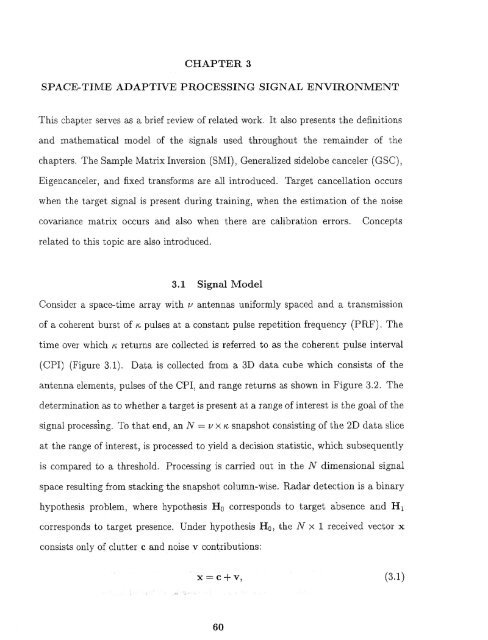Space/time/frequency methods in adaptive radar - New Jersey ...
Space/time/frequency methods in adaptive radar - New Jersey ...
Space/time/frequency methods in adaptive radar - New Jersey ...
Create successful ePaper yourself
Turn your PDF publications into a flip-book with our unique Google optimized e-Paper software.
CHAPTER 3SPACE-TIME ADAPTIVE PROCESSING SIGNAL ENVIRONMENTThis chapter serves as a brief review of related work. It also presents the def<strong>in</strong>itionsand mathematical model of the signals used throughout the rema<strong>in</strong>der of thechapters. The Sample Matrix Inversion (SMI), Generalized sidelobe canceler (GSC),Eigencanceler, and fixed transforms are all <strong>in</strong>troduced. Target cancellation occurswhen the target signal is present dur<strong>in</strong>g tra<strong>in</strong><strong>in</strong>g, when the estimation of the noisecovariance matrix occurs and also when there are calibration errors. Conceptsrelated to this topic are also <strong>in</strong>troduced.3.1 Signal ModelConsider a space-<strong>time</strong> array with v antennas uniformly spaced and a transmissionof a coherent burst of K, pulses at a constant pulse repetition <strong>frequency</strong> (PRF). The<strong>time</strong> over which n returns are collected is referred to as the coherent pulse <strong>in</strong>terval(CPI) (Figure 3.1). Data is collected from a 3D data cube which consists of theantenna elements, pulses of the CPI, and range returns as shown <strong>in</strong> Figure 3.2. Thedeterm<strong>in</strong>ation as to whether a target is present at a range of <strong>in</strong>terest is the goal of thesignal process<strong>in</strong>g. To that end, an N v x n snapshot consist<strong>in</strong>g of the 2D data sliceat the range of <strong>in</strong>terest, is processed to yield a decision statistic, which subsequentlyis compared to a threshold. Process<strong>in</strong>g is carried out <strong>in</strong> the N dimensional signalspace result<strong>in</strong>g from stack<strong>in</strong>g the snapshot column-wise. Radar detection is a b<strong>in</strong>aryhypothesis problem, where hypothesis H o corresponds to target absence and H 1corresponds to target presence. Under hypothesis Ho , the N x 1 received vector xconsists only of clutter c and noise v contributions:60
















